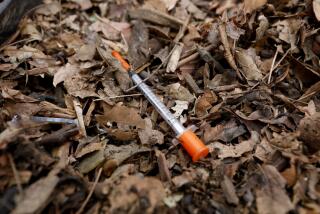HIV-Positive Nurse Calls for Safety Needles
- Share via
PHILADELPHIA — Nurse Lynda Arnold was following all the correct procedures and wearing latex rubber gloves the day she removed a catheter needle from an AIDS patient’s arm and felt it pierce her left palm.
Six months later, she tested HIV-positive.
Today, Arnold, 26, is using her experience to push for safer needle systems in the nation’s health care facilities, calling for each to sign a pledge to implement the system within a year.
“I truly think what happened to me is preventable,” she said. “I don’t want this to happen to anyone else.”
Arnold, four months out of college with a nursing degree, was working in the intensive care unit of Community Hospital of Lancaster on Sept. 9, 1992, when the AIDS patient that she was treating suddenly moved his arm, hitting hers and forcing the needle into her hand.
“It was a moment I will never forget,” she said.
She became one of the 800,000 health care workers in the United States who suffer needle-stick injuries each year.
Arnold initially tested negative, but on April 7, 1993, she was told a follow-up test was positive for the virus that causes AIDS.
According to statistics gathered by the federal Centers for Disease Control and Prevention through June 1995, 143 health care workers in the United States have contracted the virus, 46 of them in job-related incidents.
“I am one,” Arnold said. “I am living proof that needle-sticks happen and that the consequences can be deadly.”
Dr. Janine Jagger, director of the International Health Care Worker Safety Research and Resource Center at the University of Virginia, said Arnold was using a very common large-bore “introducer needle” when she was stuck.
“Once the placement of the catheter is correct, then the introducer needle is withdrawn out the back, so you have direct contact with it,” she said. “It’s a fat needle, it’s a long needle, and there’s a lot of blood in it.”
Those IV catheters and other high-risk, blood-drawing needles are what Arnold and a number of organizations, including the American Nurses Assn. and the Service Employees union, want hospitals and clinics to exchange for needles equipped with safety devices.
They allow a retracted needle to slide directly into a plastic protective sheath, Jagger said.
Already, more than 1,000 patents involve the safety needles, some spring-loaded and some manually retracted, she said.
The tough part, she said, is getting hospitals to adopt new procedures and products.
“There’s so much bureaucracy and so many hurdles to go through in order to actually get them in the hospital,” she said.
“The limiting factor is the hospital door.”
Arnold’s hospital was in the process of testing the safety needles when she was stuck. They are now standard there.
“In retrospect, we certainly wish that these were in effect at the time of Lynda’s unfortunate accident,” said hospital spokesman Mike Capabianco.
Arnold, who left the hospital under workers’ compensation, said she did not hold any ill will toward her former employer.
“I wish they had had them,” she said. “But it won’t happen again at my hospital, and I’m happy about that.”
Arnold, who has a 10-month-old adopted son, said she’s undaunted by the prospect of meeting resistance to the safety needles from hospital administrators.
“I feel like it’s a calling for me,” she said. “It alone keeps me going.”
More to Read
Sign up for Essential California
The most important California stories and recommendations in your inbox every morning.
You may occasionally receive promotional content from the Los Angeles Times.












